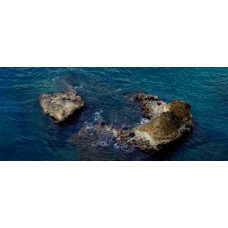From the ancient Greek μέρος 'part' and μίξις 'mixture'.
A body of water in which there is virtually no water circulation between layers of different salinity, separated by the so-called chemocline, as a result of which the water of the lower layer is more saline and dense than in the upper layer.
The term "meromictic" as applied to water bodies was introduced in 1935 by the Austrian limnologist I. Findenegg, and after a substantial revision of the concept of meromictic water body in 1937 and the introduction of the term "chemocline" by the British limnologist and ecologist J.E. Hutchinson it became commonly used.
Along with meromictic reservoirs in the narrow sense, in which water circulation between layers is practically absent, a more numerous group of meromictic reservoirs in the broader sense is considered, in which such circulation does sometimes take place, but is irregular, sporadic in nature.
The largest meromictic body of water is the Black Sea, 5/6 of the water column of which contains hydrogen sulfide (which makes this layer unsuitable for life of organisms that need the presence of oxygen).
Examples of meromictic reservoirs in Russia are Lake Mogilnoye on Kildin Island (in the Barents Sea, near the coast of the Kola Peninsula) and Lake Shira in Khakassia. Lake Mogilnoye is separated from the sea by a boulder cofferdam, which, according to different estimates, appeared from 1,000 to 3,500 years ago. There are three layers in this lake: the surface layer with almost fresh water, a layer of sea water 5 to 9 meters deep, and a lower layer (up to the maximum depth of 17 meters), where the water lacks oxygen and is saturated with hydrogen sulfide. Each of the layers is characterized by its own flora and fauna, so that three ecosystems coexist in the lake: with freshwater organisms near the surface, typical marine organisms (including cod) in the middle layer and bacterial flora in the bottom layer. In Lake Shira, the desalinated surface layer and the saline, hydrogen sulfide-saturated layer are separated by a thin (5 cm) intermediate layer enriched with oxygen and home to a large number of photosynthesizing purple bacteria.
The scene of an ecological catastrophe in August 1986 was the vicinity of the Cameroonian high-mountain meromictic Lake Nyos. Then the bottom waters of this crater lake, saturated with volcanic gases (primarily carbon dioxide), suddenly burst to the surface. As a result, within a few hours a huge amount of carbon dioxide was released into the area around the lake, spreading almost 30 km; more than 1,700 people and 3,500 cattle died of suffocation.
Two-layer lake
Tags: two-layer lake

